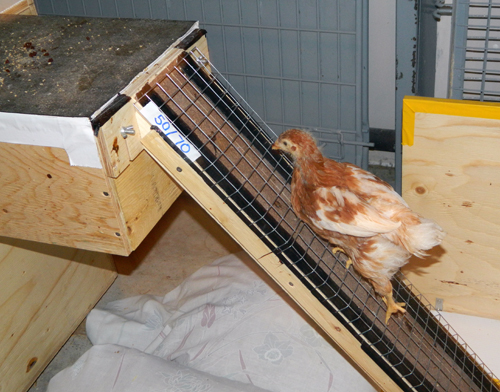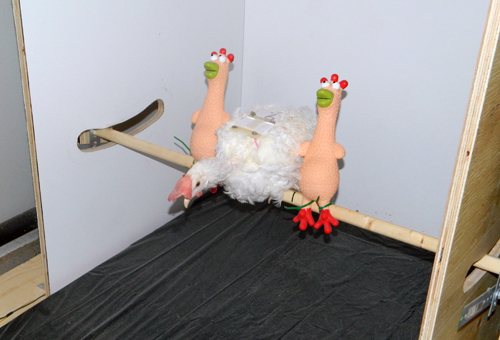
As people learn more about the conditions in which chickens are kept on commercial farms, pressure for change is growing. Europe has already banned the use of cages, and Canadian recommendations are moving towards requiring less-restrictive forms of housing as well. Instead of having several birds in a single tiny cage, more farms now have aviaries, where a large number of birds are kept in an open area, often with several levels.
While these “cage-free” settings sound like an improvement, researchers are finding high rates of injury among their occupants. Chickens that are not kept in cages, for example, have a rate of breastbone fractures between 52 and 80 per cent. The rate of feather-pecking may also be higher in these settings than when the birds are in cages.
Animal and poultry professor Alexandra Harlander is looking for solutions to these problems and hopes that adjustments to the aviary designs might make a difference.
“The design of these aviaries has not been researched,” she says. “We are working on better understanding how chickens move and behave so that more appropriate designs can be created for them. Instead of us trying to think what a chicken might want, we are letting the chickens tell us what matters to them.”
At U of G’s Arkell Poultry Research Station, Harlander’s grad students have built enriched pens for the chickens they are studying. Each pen has several levels and two ramps – one made of a series of perches and one that is a solid ramp with narrow boards nailed across it. There are also perches of varying thicknesses, and what Harlander calls a “brooder box” – a wooden box with plastic flaps that provides a sheltered, darkened environment.

Her studies start with groups of one-day-old chicks in each pen. “We are starting with very young chicks because in most of the commercial facilities the birds are not introduced to the aviaries until they are older,” Harlander says. “We want to see if part of the problem is that they have been confined and not learned how to navigate the aviary space.”
Each chick is equipped with a little “backpack” that contains a tiny removable electronic recording device to track its movements. A camera in the pen also records what the chicks are doing so that those details can be correlated to the data on the recorder.
Madison Kozak, a master’s student in Animal Behaviour and Welfare who is working on this study, says they have observed that even at five weeks old, the chickens like to hide and shelter in the brooder area. Farmed chickens are normally exposed to light for many hours a day, depending on their age, and have no opportunity to find dark places to rest. Having longer periods of darkness seems to reduce the pecking and feather-plucking that is a significant problem for chicken farms.
She’s also noticed that certain types of chickens prefer the ramp consisting of a series of perches while others prefer the solid step-up ramp. Some prefer to be on higher levels while others like to spend more time at ground level.
In another pen, Chantal Leblanc, a master’s student in Animal Behaviour and Welfare, and Haley Leung, a second-year Animal Biology student, have set up an adjustable ramp. Leblanc explains that no previous research has been done on what ramp angle or design is the most appropriate for chickens.
For each trial in the experiment, the ramp is set at an angle between 70 degrees and 10 degrees, and the chicken sees that some of its friends — and some food — are waiting at the top of the ramp. The chicken is released at the bottom of the ramp, and a camera records how it gets to the top.
A force plate at the bottom of the ramp tracks the amount of force each chicken uses to start up the ramp. “We are determining what they can comfortably and safely do, without overtaxing the birds,” Leblanc says.
Leung weighs the birds weekly and measures their wingspan to see how their increasing weight affects their ability to fly. She also takes photos to record how their feet grow week by week.
Graduate student Stephanie Leblanc is using a couple of rubber chickens tied to a perch to learn more about how so-called production diseases such as foot damage can affect a chicken’s balance. The rubber chickens help to simulate the crowded conditions of the aviary.
Once the chicken being studied is placed on the perch, the rubber chickens are pressed against both sides of its body, and a motor starts to gently swing the perch back and forth. The chicken’s movements and attempts to maintain balance are recorded. Other variations include putting a mask over the chicken’s head to simulate low-light conditions or vision loss.

Candace Martins, also an Animal Behaviour and Welfare student, analyzes the social and play behaviour of the chickens in these enriched pens. From an early age, the chicks run around together, chase each other, pick up bits of straw and toss them playfully, and run up and down the ramps. They also enjoy dust-bathing – wriggling into the dirt or bedding on the ground while ruffling their wings. Birds who engage in social play may be less likely to peck others when they are older.
Harlander was born in Austria and attended veterinary school in Vienna. She continued with poultry research at the University of Hohenheim in Germany and the University of Bern in Switzerland. She says poultry welfare has been a focus of her research from the beginning.
“There are more than five billion chickens around the world at any one time,” she says, “yet there has not been a lot of research on them. We think these studies can help to improve their lives, and the Canadian poultry industry is very interested in what we learn.”